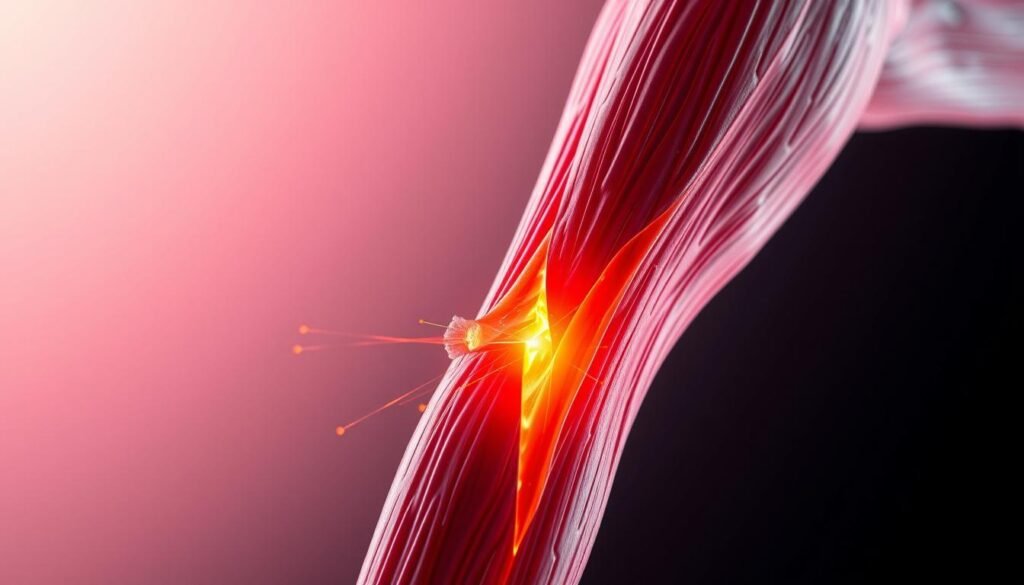Did you know that nearly 70% of athletes feel muscle fatigue during their training or games? This fact shows how common muscle fatigue is, affecting everyone’s performance and daily life. It happens when our muscles are pushed hard, leading to weakness, soreness, and sometimes pain. Understanding the signs of muscular fatigue and how to recover is key. This is essential for keeping up with physical health and staying active.
In this article, we’ll explore what causes muscle fatigue. We’ll look at its symptoms and share top tips for recovery. This will help anyone facing this issue to get back on track fast!
Key Takeaways
- Muscle fatigue comes from many sources, like exercise, aging, and health issues.
- Common signs are feeling weak, sore, and out of breath.
- Rest and drinking water are crucial for getting better.
- If fatigue lasts long, it might show a bigger problem.
- Heavy workouts influence how muscles perform and recover.
- Knowing how to recover can improve how well athletes do.
What is Muscle Fatigue?
Muscle fatigue is when you find it harder to do physical tasks. It affects daily life and sports performance. Knowing about muscle fatigue definition is key for people who exercise or play sports. It means your muscles can’t do as much as usual. You might feel weak or tired. This can change how well you move or play.
Definition and Importance
The muscle fatigue definition includes different reasons why it happens. It can come from hard exercise or long activities. It’s important for athletes and anyone who exercises to know about muscle fatigue. It can change how long you can run, how strong you are, and how fast you move. Muscle fatigue shows limits in what your body can do. It also tells you about your health. If it’s not because of normal exercise or getting older, you might need to check it out.
Differentiating Acute and Chronic Muscle Fatigue
There are two main types of muscle fatigue: acute muscle fatigue and chronic muscle fatigue. Acute muscle fatigue happens after hard exercise. It goes away if you rest enough. This is normal when you push yourself hard in sports or working out.
But, chronic muscle fatigue lasts a long time. It might mean there are health problems. It can come from getting older or being sick for a while. Knowing the difference helps to find the best way to get better. It lets you know if you need to see a doctor. To learn more, check this informative source.
Common Causes of Muscle Fatigue
Muscle fatigue happens for various reasons that affect how we feel and perform. Knowing why it occurs is key to dealing with it. Let’s look at what causes muscle tiredness.
Exercise and Physical Activity Impact
Whether you’re a gym newbie or a pro athlete, exercise makes you tired. Hard or long workouts burn oxygen and energy. This makes muscles work less well. During exercise, low oxygen, poor calcium release, and toxin buildup weaken muscles. Not drinking enough water can make it worse. So, staying hydrated is vital.
Health Conditions Associated with Muscle Fatigue
Many health problems play a role in muscle fatigue. Issues like fibromyalgia, anemia, and infections (Lyme disease or COVID-19) cause ongoing weakness. Neurological illnesses such as multiple sclerosis and ALS also lead to fatigue. Muscle mass drops with age, starting at 40. If muscle tiredness is bad, it might be due to a health condition needing a doctor’s care.
Effects of Medications on Muscle Fatigue
Some medicines can make muscles weak. Antibiotics, drugs for immune suppression, and chemotherapy are known for this. Illegal drugs like cocaine or opioids also cause serious tiredness. Understanding how medications affect muscle tiredness is important for managing it better.
Signs and Symptoms of Muscle Fatigue
It’s important to recognize the symptoms of muscle fatigue early. This ensures the right treatment is started quickly. Signs can vary and show how serious the condition is. Knowing them helps decide if more help is needed.
Physical Indicators
Muscle fatigue shows up in a few clear ways, such as:
- Muscle weakness: This can happen due to not moving much, getting older, injuries, or conditions like pregnancy.
- Soreness: This is usual after doing a lot of exercise.
- Localized pain: This might mean there is an injury or strain to the muscle.
- Cramps: These sudden, sharp muscle contractions can mean you’re overdoing it or not drinking enough water.
- Twitching: A hint that muscles are tired or not getting enough electrolytes.
- Trembling: This happens often when under a lot of physical pressure.
Chronic diseases like diabetes, lung disease, and heart failure can cause long-term muscle fatigue. Mental health issues such as anxiety and depression can make fatigue feelings worse.
When to Seek Medical Attention
If muscle tiredness stays for more than two weeks or gets worse, even with rest, see a doctor. Some warning signs for urgent medical help include:
- Severe muscle weakness: Along with rhabdomyolysis signs like dark urine and less pee than usual.
- Shortness of breath: This could point to lung or heart problems.
- Persistent pain: Pain that stops you from doing everyday things or keeps getting worse needs checking.
Knowing when to take these symptoms seriously is crucial for your health. Getting checked early can stop worse problems and help you get better quicker.
Mechanisms Behind Muscle Fatigue
Learning about muscle fatigue shows us how our bodies deal with hard work. We can look at muscle fatigue in two main ways: central fatigue and peripheral fatigue. Understanding these can help us train better and recover faster.
Peripheral vs. Central Fatigue
Peripheral fatigue happens within our muscles, caused by things like changes in metabolism and damage to muscle fibers. It usually starts at the point where nerves meet muscles. On the other hand, central fatigue is about our nervous system. It affects how signals are sent to muscles, making it hard for them to contract.
Knowing the difference between these two types helps in improving how we perform and recover.
The Role of Muscle Metabolism
Muscle metabolism is key to creating energy when we’re active. ATP is the main source of energy for muscles, but it runs out quickly when we’re pushing hard. How well we can use phosphocreatine and oxygen impacts how long we can keep going.
When we run out of energy sources, we feel muscle fatigue. Both central and peripheral issues, like metabolic waste, play a role in how well we do and how quickly we bounce back.
Lactic Acid Buildup and Its Effects
Lactic acid is a big reason we feel muscle fatigue during tough workouts. It makes the pH in our muscles drop, which can hurt and change how our muscles work. But lactic acid is just one part of why our muscles get tired when we’re active.
Differences Between Muscle Fatigue and Delayed Onset Muscle Soreness
Knowing how muscle fatigue and delayed onset muscle soreness (DOMS) differ helps in recovery. Muscle fatigue happens right after heavy exercise. The end of a workout feels harder than the start. This happens due to a mix of electrical and chemical changes in our muscles.
Conduction failure and lactic acid build-up can make muscles contract less efficiently. These issues change how well the muscle responds to your commands. They make it harder to keep going strong during exercise.
Understanding DOMS
DOMS starts 12 to 24 hours after exercise. It’s caused by tiny tears in the muscles from hard or new workouts. You’ll feel sore and stiff, mostly between one to three days later.
As your muscles get used to the exercise, soreness fades. Stretching, massages, and other therapies help muscles bounce back. These methods boost blood flow and reduce swelling.
How Both Affect Muscle Recovery
Muscle fatigue can lower your during-exercise performance. On the other hand, DOMS can make it tough to move for days. A good warm-up helps balance electrolytes and reduces lactic acid, aiding recovery.
Staying hydrated is also key to reducing soreness and speeding up recovery. Knowing how fatigue and DOMS differ aids athletes in picking the right recovery plans.
Recovering from Muscle Fatigue
Recovering from muscle fatigue is key for best performance in sports and workouts. To recover well, you need to rest and eat right. Our muscles need time to heal and get stronger after we exercise. This can take between 24 to 72 hours depending on how hard we worked out. Resting helps keep us from getting hurt and makes us better in our next sessions.
Importance of Rest and Recovery
Rest is a big part of getting better after exercising. Getting enough sleep is super important. It helps with inflammation and making hormones that fix our muscles. If we don’t sleep enough, we might not heal right and could get injured. Letting our muscles rest makes them stronger for our next workout.
Nutrition and Hydration Strategies
Eating right is important for getting past muscle tiredness. A diet with lots of protein, carbs, and healthy fats helps repair muscle. You should try to get about 1.6 grams of protein for every kilogram you weigh every day to grow muscles. Drinking enough water is also crucial. You should drink 1.5 liters of water for every kilogram you lose when you exercise. Foods like cherry juice, which have antioxidants, also help in getting over muscle fatigue.

Using creatine monohydrate with workouts can make you stronger and help in recovery. Having the right amount of magnesium and calcium is important too. It can prevent cramps and increase energy. These nutrition tips help your body recover better and fight off tiredness. For more tips on how to get better after a workout, visit this helpful resource.
Effective Techniques for Muscle Recovery
Muscle recovery is key for top performance and health. Using the right recovery methods, we can lessen soreness and boost flexibility. Techniques like stretching, hot and cold therapy, and compression wear are popular for their benefits.
Stretching and Its Benefits
Stretching has many perks, including making you more flexible and improving circulation. Starting workouts with dynamic stretches—like jogging or jumping jacks—gets muscles ready for action. Then, doing static stretches for each muscle for 60 seconds after working out helps ease tightness and aids in recovery. These simple steps are big for recovery and better performance.
Hot and Cold Therapy
Hot and cold therapy works well for muscle recovery. Heat, like from hot packs, boosts circulation and loosens tight muscles. Cold, from ice packs or cold baths, cuts down on inflammation and swelling. Cryotherapy chambers, which use extreme cold, are great for injury recovery because they lessen soreness fast. Using both heat and cold can give the best muscle relief.
The Role of Compression Garments
Compression gear, such as tights and sleeves, helps with recovery. Wearing them right after tough workouts boosts blood flow and reduces soreness. They support muscles and stabilize tissue during recovery, making them a smart choice for any workout plan.
Adding these recovery techniques into your routine can better your performance and make recovery smoother. This lets you stay active and keep up with your fitness goals.
The Impact of Exercise-Induced Muscle Damage
Intense workouts can lead to muscle damage, known as exercise-induced muscle damage (EIMD). This involves tiny tears in muscle fibers. It causes soreness, fatigue, and a temporary drop in strength. Even though EIMD is part of muscle growth, balancing hard workouts with enough rest is key.
Understanding the Effects of Intense Workouts
Intense and eccentric workouts can cause structural muscle injuries due to EIMD. In sports like soccer, muscle issues lead to about 12% of a season’s missed games. The hamstring is often most affected, with teams seeing up to seven strains in a season. Muscle fatigue and many games up the injury risk. Individuals need to know how EIMD can make injuries more likely.
How to Minimize Muscle Damage
To lower muscle damage, start with good warm-up routines. Gradually upping workout intensity helps the body adjust. It’s crucial to take rest days for muscle repair and growth. Blackcurrant extract can also cut down on creatine kinase levels, aiding recovery.
For more facts on muscle damage and healing, check this research link. Using these tips, you can work out smarter and cut down injury risks from muscle damage.

Preventing Muscle Fatigue
To avoid muscle fatigue, balance in fitness and health is key. Working out often boosts muscle endurance and strength. This makes it easier to fight off fatigue. It’s important not to overdo it though. Recognizing early signs of overtraining is crucial. This prevents serious health problems.
Importance of Regular Exercise
Staying active is essential to beat muscle fatigue. You should do moderate aerobic exercises for at least 150 minutes each week. Plus, add two sessions to make your muscles stronger. These efforts not only increase strength but also improve heart health.
Varying your activities, like running, biking, or swimming, helps a lot. Remember to rest enough between workouts. Muscles need 24-48 hours to recover, sometimes even more. Drinking plenty of water, about 10 to 12 8-ounce glasses daily, is also crucial.
Signs of Overtraining to Watch For
Overdoing workouts can cause many problems. Look out for signs like constant tiredness, ongoing muscle pain, and dropping performance levels. If muscles feel weaker, making usual exercises seem hard, take note. Always listen to what your body tells you.
If tiredness doesn’t improve after two weeks, see a doctor. It’s important to check if it’s something serious, like rhabdomyolysis. Keeping an eye on these symptoms helps keep you healthy and avoid burnout.
Additional Strategies for Enhancing Muscle Endurance
Muscle endurance is key if you want to perform better in sports or stay active longer. There are many ways to boost your endurance effectively.
The Role of Caffeine and Creatine Supplements
Caffeine supplements help a lot with muscle endurance. Taking them before workouts boosts both endurance and strength. Creatine supplements are also great. They help you make energy for tough exercises. This lets you work harder and feel less tired. Adding these to your workout routine can really up your game.
Strength Training and Its Benefits
Strength training is awesome for better endurance. It makes your muscles stronger, so they get tired less easily. Doing different exercises, like pushups, squats, and lunges, works out various muscles. Having both strength training and endurance exercises in your plan makes you perform better.

| Supplement | Benefits |
|---|---|
| Caffeine | Improves muscular endurance and strength, particularly during workouts |
| Creatine | Supports energy production during high-intensity exercises, reducing fatigue |
To see real gains in muscle endurance, stick with these methods and give it about four weeks. Mixing up different fitness parts helps you grow without getting hurt.
Conclusion
Understanding muscle fatigue is key for anyone active, from casual enthusiasts to pro athletes. It’s important to know the signs of fatigue and what causes it. This knowledge helps in using recovery tips to stay in top form during training and competition.
Advances in how we understand muscle metabolism and different muscle fiber types offer great insights. They help in making better plans for performance and recovery.
Muscle fatigue greatly affects physical performance. Athletes with more type II muscle fibers may see a big dip in strength during hard workouts. That’s why special recovery plans, which include the right food and drinks, are crucial. They boost stamina and help keep performance levels steady.
In summary, dealing with muscle fatigue proactively is smart. Using effective recovery methods can boost your performance. It makes exercising more fulfilling. Recovery is not just about beating fatigue. It also supports ongoing athletic growth. This makes your fitness journey more rewarding and fun.